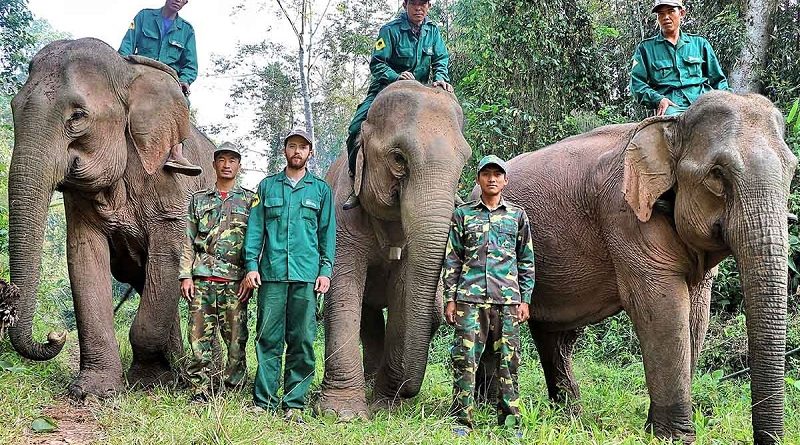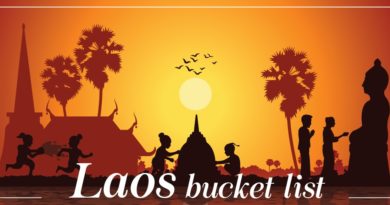Crazier Than Fiction: The Elephant Rangers of Laos
Written by Melody Kemp, published in Wildlife
An innovative project to utilise Laos’ elephant experts in service of protecting the country’s natural treasures is waiting on just one thing – government approval
Four years ago, as monsoon rain streaked down dusty windows, Sebastien Duffilot, the founder of Laos’ Elephant Conservation Centre (ECC) in Xayaboury, near Luang Prabang, and I sat discussing the possible fate of Laos’ elephants. We sipped a good French red wine, which encouraged dreaming and fantasies about a land whose tradition was founded on the courage and tenacity of these great beasts, but which now is prey to the cold-eyed attention of poachers.
Laos’ current elephant population is estimated at between 400 wild and 450 domesticated variants. Laos, once known as The Land of a Million Elephants, has seen a devastating drop in numbers – almost 90 per cent – since 1988. Deforestation leading to loss of income for mahouts (elephant handlers), habitat fragmentation, human elephant conflict, slow breeding cycles, and now the plans for a Chinese-built, high-speed rail line which cynics believe is simply the way for the small country’s northern neighbours to empty the biological pantry, all make Duffilot fear that elephants could be extinct in Laos by 2030.

From the rich cache of ideas we hatched, I wrote a book for young adults – Big T’s Song outlines the mahout’s dilemma: The jungle’s all gone, so what hope for logging elephants that need anything up to 250kg of food per day? My solution was a mounted park ranger service, using elephants to patrol the land.
The issue took on sharp realism earlier this year when Dubai, now recognised as being a hub for wildlife trafficking, ordered 16 elephants, ostensibly for its zoo, via South Korean dealers. The two million dollars they offered barely covered real costs, but attracted many desperate mahouts. Thirteen animals were rounded up.

The cargo plane was sitting on the runway at Wattay International airport in Laos’ capital, Vientiane, with engines running, when the order came from Laos’ prime minister Thongloun Sisolith to cancel the sale and the export. An Indiana Jones moment.
There were demands the money be repaid. Fat chance. The mahouts faded into the jungle and the 13 elephants were left stranded. Sisolith offered them instead to the ECC who took gratefully them in. To sweeten the deal, he granted them extra land and custody of the adjacent Nam Phouy National Protected Area (NPA), a wild precipitous area at the border with Thailand. The ECC then inherited the same mahout’s dilemma. How to feed and protect all those additional animals. An Elephant Mounted Ranger service was suggested. Fiction became fact.

An image from Melody’s book showing elephant-mounted rangers (Illustration: Magda Korotynska)
The Nam Phouy Protected Area
The contour maps show sheer limestone cliffs and forest-covered mountains rising to over 1,700 metres, relieved by streams and lowland (200m) forests. Camera traps have revealed what look to be small wild elephant herds; most significantly, with several elephant calves. The area’s inaccessibility may be the animal’s best protection.
Liverpudlian Michael Falshaw is the ranger project’s coordinator. ‘I work at the ECC currently in forest management, mapping and surveying. I’m here almost by accident, but with a passion for forests in particular. Nam Phouy is infamous for its steepness, which I would say definitely plays a role in conserving its biomass and makes a good poaching deterrent. The obvious emphasis will be in wildlife protection but, for me, forest conservation and wildlife conservation go hand-in-hand. By protecting the forest, you ensure the animals have a home, and in order to protect wildlife you must protect their home.’

The ECC cannot start official patrols until it has a go-ahead from the region’s governor. And not before it is completely sure that everyone involved is ready, competent and certain of their responsibilities. ‘Training’s one thing, but making sure they are confident and motivated enough to carry out their new role, is another. The mahouts need to learn the full scope of the four patrol ranger’s jobs, the laws of the NPA and, most importantly, the confidence and motivation to confront people who break those laws in the field.’

Most Lao elephants are today used for tourism activities
Several months later they are still waiting. I meet up with the ECC team in Vientiane and of course my first question is whether national approval hascome through? The answers came from both Michael and Joe, the administrative manager. Michael replies ‘No but… we have started informal operations anyway.’
Joe adds: ‘The provincial people are going ahead as they want this to work. The national government is playing hard to get so we will give up chasing it and instead focus on the elephants.’
‘The Lao people are intensely social, so its important we have the two (government and mahouts) working together,’ Michael says. ‘Being alone in the forest is hard psychologically; motivation levels drop significantly. Besides mahouts have no power of arrest or option to carry weapons. We hope to end up with teams comprising two or three NPA guards with two military and possibly one local guide depending on the area being patrolled and the guard’s knowledge of that area. There are around 11 Forest Guards who will work for the NPA full-time, but feet on the ground may be larger when we include a military presence and local guides.’
Michael hopes to start with six mahouts mounted on elephants. ‘These guys, more than anyone, know elephants,’he says. ‘They will be hugely valuable in tracking their migratory routes, telling us about herd sizes and behaviour. One person in the forest alone would not feel confident – even with their elephant – to confront anyone they thought was up to funny business.’

A mahout and his elephant
I ask about the advantages of having elephant-mounted rangers. ‘There are some physical advantages, such as the ability to carry more equipment and supplies in order to go on longer excursions into the forest. But I think the main advantages are social and economic ones for the people who live around the park. Creating jobs for mahouts – whose main role in the past was to log with their elephants – to protect the forest using essentially the same skill set is a fantastic way to change the mindset of local people and have them see monetary value from protection of the forest.’
I half-jokingly ask if the uniforms were sensational. Duffillot after all started his life as a graphic designer. Michael’s answer confirms the importance of belonging and identity: ‘The rangers are very happy with them. I think they are an important part of their pride in being part of this team.’
There is a natural synchronicity between the government and the ECC’s mahouts who know the forest and whose sure-footed charges can take them into tough terrain. ‘We have unemployed elephants and mahouts. We have wild elephants and forest that needs protecting. Mahouts know a lot about forests and a lot about elephants – it all fits together beautifully. It’s a really cool and interesting way to get things done but it may not fit all situations. Elephant rangers are used in South Asia. Hopefully our elephant rangers will be the first in this Mekong region.’
The ranger patrols are clearly needed. As Michael explains: ‘The possibility of rich people from neighbouring countries coming here to claim exotic animals including elephants, is something we will always have to monitor and tackle. From what our mahouts tell me almost all elephants with tusk’s have been killed. But until we have official permission to be snooping around the area, this is all still speculation.’

A Lao mahout washing his elephant
Hold ups
So with an amazing ECC facility containing innovative, highly motivated staff envisaging a life for elephants right up against elephant-hungry China and Vietnam, one would think it a PR coup for the government to step forward and give it the thumbs up.
However Laos retains its old-style national administrative system, one meant to maximise political control. Donors, agencies and Lao people have voiced increasing frustration in the face of endless obfuscation from a regime whose main skill seems to be doing nothing.
That might change soon though as the ECC scored the winning honours in the ‘Must Do’ class at the ASEAN Tourism Forum in January. A communique to Geographical from Duffilot following this award advised: ‘We have submitted our final feasibility study to the (national) government and we are expecting a positive answer soon. Anyway, we have been working with government people hand-in-hand in the National Protected Area for over six months now, so I guess we’re sort of welcome.’
In the face of dropping numbers, the rangers’ ability to spot potentially threatened grids and monitor movements seems vitally important. Unfortunately despite the provincial authorities being eager to start patrolling, they need the imprimatur of national officialdom. It’s hard for them not to be impatient.


